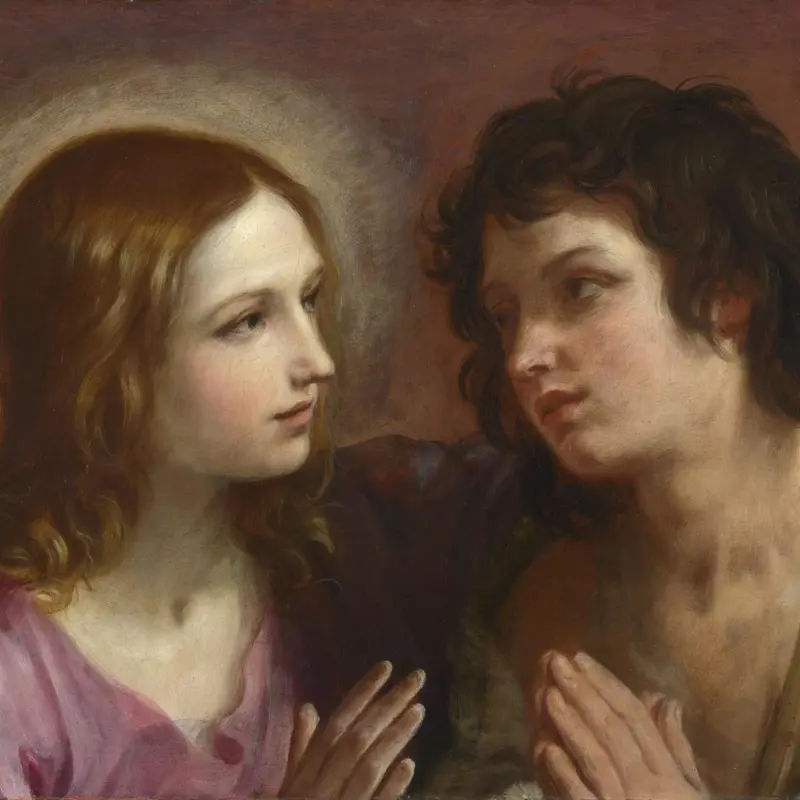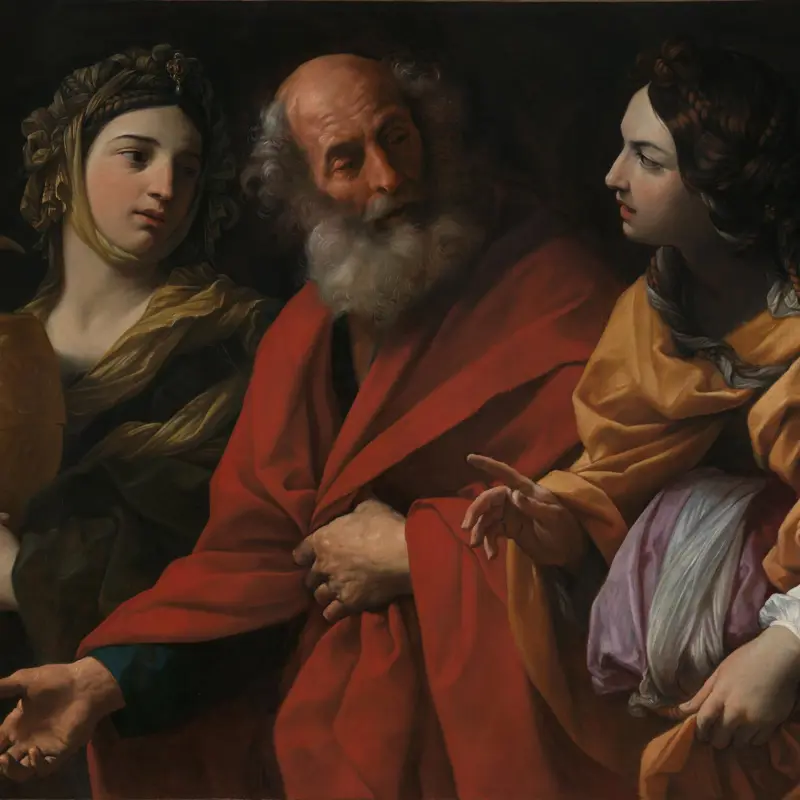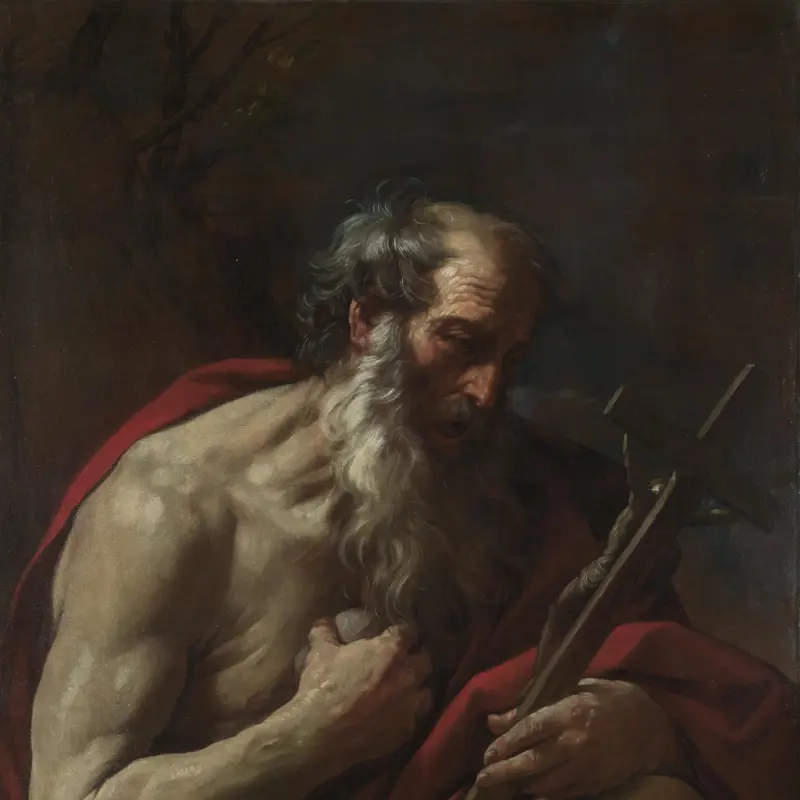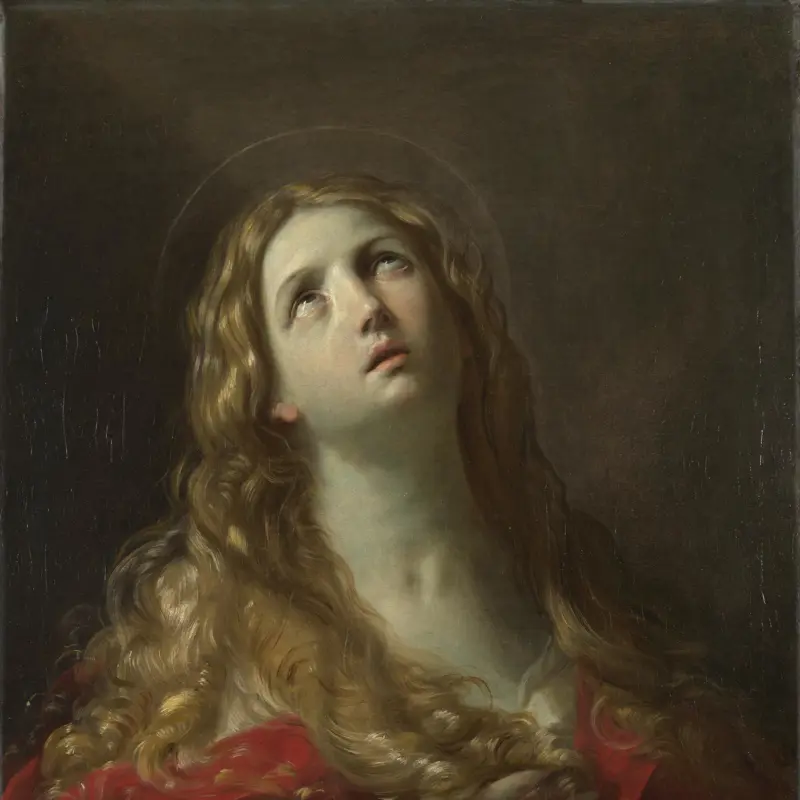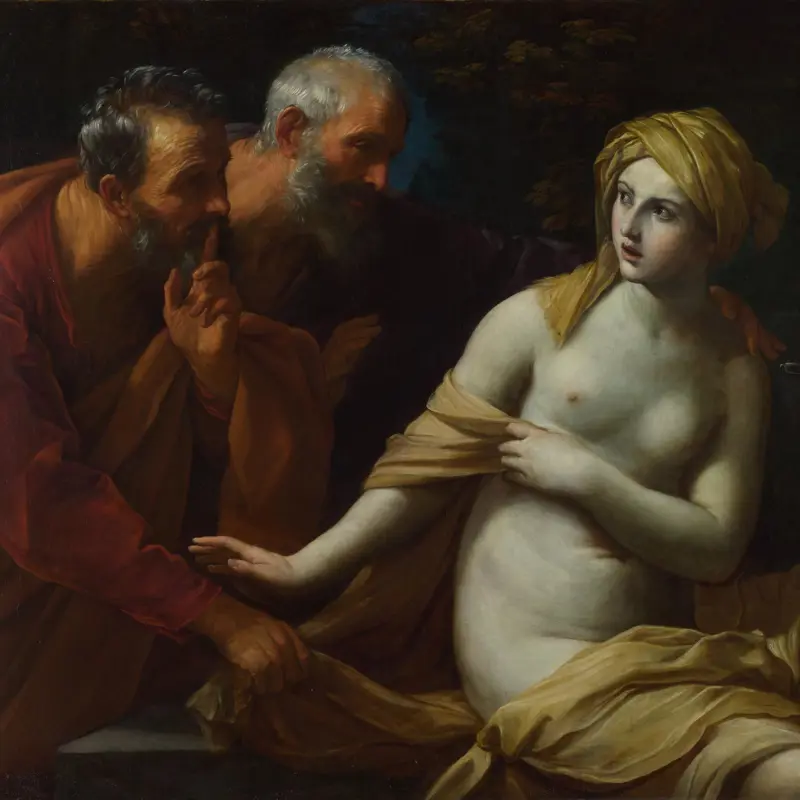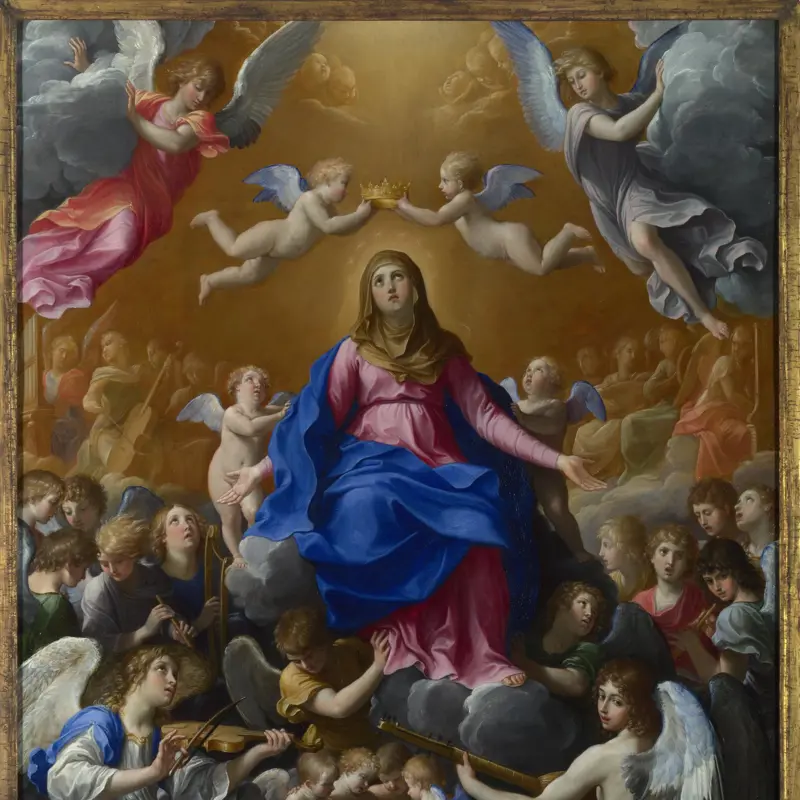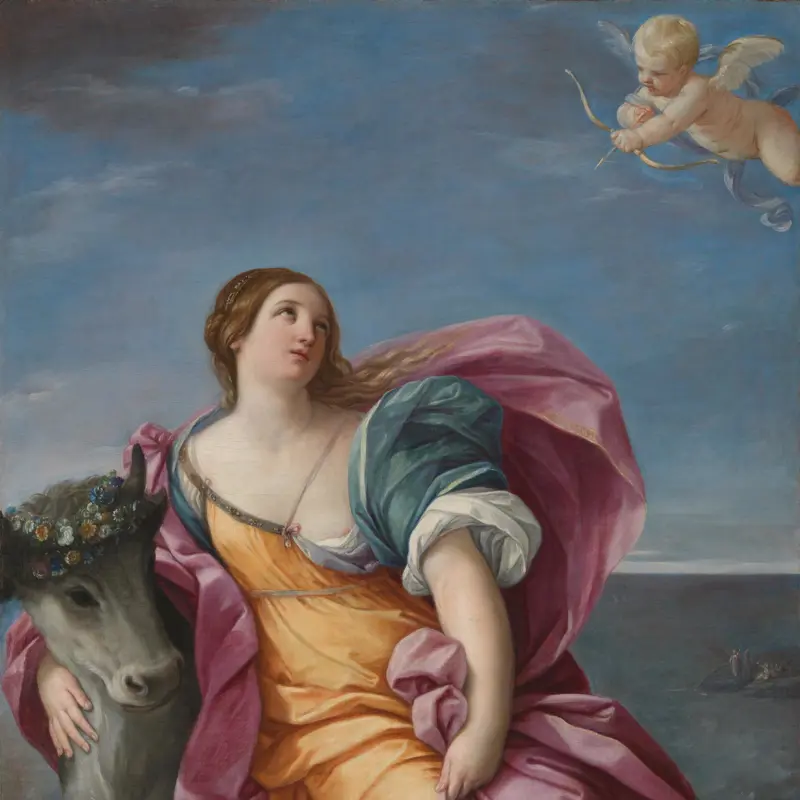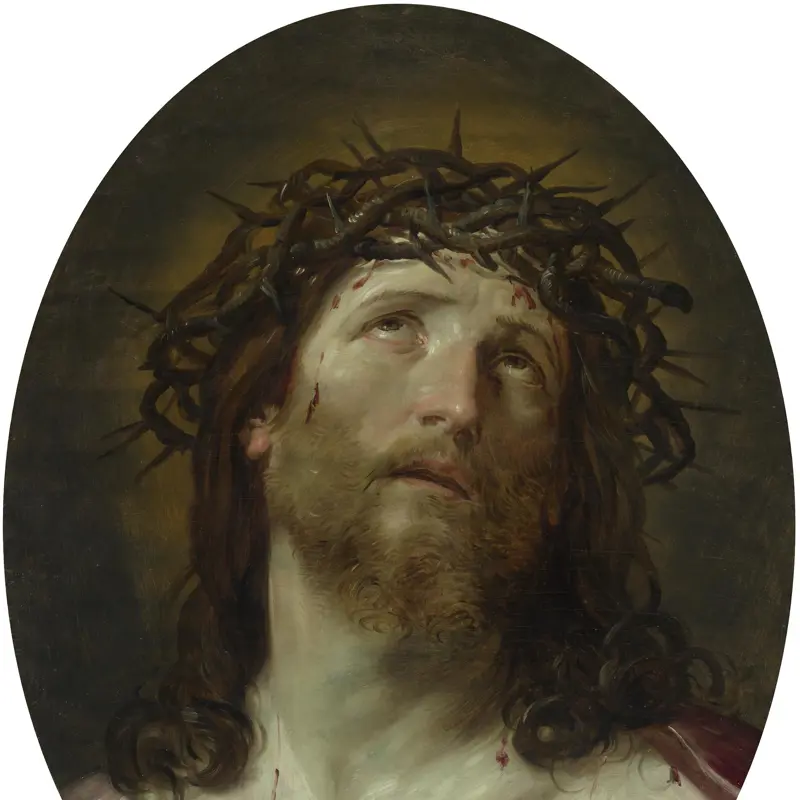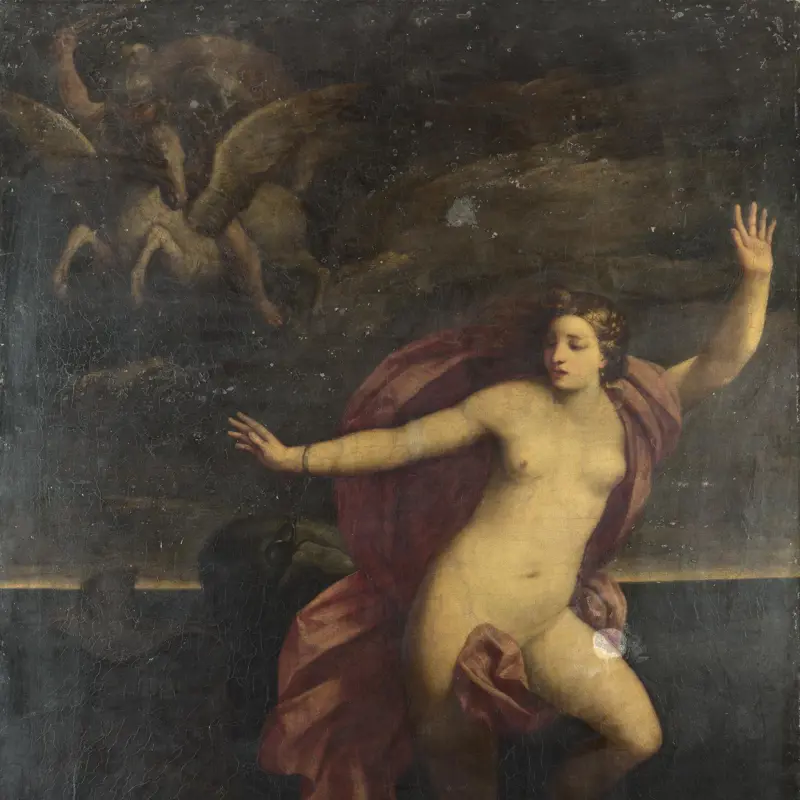Guido Reni and Studio, 'The Toilet of Venus', about 1620-5
About the work
Overview
In this monumental painting, Venus, the goddess of love, is attended by the Three Graces, who carefully fasten her sandals and jewellery. Her son Cupid stands before his bow and arrow in the foreground, delicately holding a pearl earring between forefinger and thumb, while a putto reaches through the window to place a flower amongst an arrangement in an antique urn. The semi-reclining goddess is shown with lips parted and eyes looking heavenward – an expression that came to be associated with both religious and secular women in Guido Reni’s paintings.
Multiple versions of this composition are known, and this painting was previously considered a copy carried out by Reni’s studio assistants. Recent conservation treatment has, however, revealed far more of Reni’s hand at work than had previously been thought. A strong argument has been made for it being the work painted for Federico Gonzaga, Duke of Mantua, and delivered to him in around 1623.
Key facts
Details
- Full title
- The Toilet of Venus
- Artist
- Guido Reni and Studio
- Artist dates
- 1575 - 1642
- Date made
- About 1620-5
- Medium and support
- Oil on canvas
- Dimensions
- 281.9 × 205.7 cm
- Acquisition credit
- Presented by William IV, 1836
- Inventory number
- NG90
- Location
- Not on display
- Collection
- Main Collection
- Previous owners
- Frame
- 19th-century English Frame
Provenance
Additional information
Text extracted from the ‘Provenance’ section of the catalogue entry in Michael Levey, ‘National Gallery Catalogues: The Seventeenth and Eighteenth Century Italian Schools’, London 1986; for further information, see the full catalogue entry.
Exhibition history
-
2018Charles I: King and CollectorRoyal Academy of Arts27 January 2018 - 15 April 2018
-
2022Guido Reni: The Beauty of the DivineMuseo Nacional del Prado28 March 2023 - 9 July 2023
Bibliography
-
1681F. Baldinucci, Notizie dei professori del disegno da Cimabue in qua, Florence 1681
-
1742G. Bickham, Deliciae Britannicae or the Curiosities of Kensington Palace, Hampton Court, and Windsor Castle, 2nd edn, London 1742
-
1757A. van der Doort, A Catalogue and Description of King Charles the First's Capital Collection of Pictures, Limnings, Statues, Bronzes, Medals, and Other Curiosities: Now Published from an Original Manuscript in the Ashmolean Museum at Oxford, the Whole Transcribed…by the Late Ingenious Mr Vertue, ed. G. Vertue, London 1757
-
1759R. Strange, A Collection of Historical Prints, London 1759
-
1761London and Its Environs Described: Containing an Account of Whatever is Most Remarkable for Grandeur, Elegance, Curiosity or Use, in the City and in the Country Twenty Miles around it, 6 vols, London 1761
-
1766T. Martyn, The English Connoisseur, London 1766
-
1769R. Strange, Catalogue of Mr Strange's Works Engraved After Pictures of the Most Celebrated Painters of the Roman, Florentine, Lombard, Venetian and Other Schools, London 1769
-
1819W.H. Pyne, History of the Royal Residences, London 1819
-
1842Mrs Jameson, A Handbook to the Public Galleries of Art in and Near London, London 1842
-
1845G. Foggo, A Catalogue of the Pictures in the National Gallery with Critical Notes, London 1845
-
1854G.F. Waagen, Treasures of Art in Great Britain: Being and Account of the Chief Collections of Paintings, Drawings, Sculptures, Illuminated Mss. […], vol. 2, trans. E. Eastlake, London 1854
-
1885W. Braghirolli, 'Guido Reni e Ferdinando Gonzaga', Rivista storica mantovana, I, 1885, pp. 88-99
-
1913A. Luzio, 'La corrispondenza degli archivi di Mantua e Londra concernente la vendita del 1627-28', in A. Luzio, La Galleria dei Gonzaga venduta all' Inghilterra, Milan 1913, pp. 137-67
-
1927P. Toynbee, 'Horace Walpole’s Journals of Visits to Country seats, &c.', The Walpole Society, vol. 16, 1927-28, pp. 9-80
-
1931G. Vertue, 'Vertue Note Books, II', The Walpole Society, XX, 1932
-
1933G. Vertue, 'Vertue Note Books, III', The Walpole Society, XXII, 1934
-
1935G. Vertue, 'Vertue Note Books, IV', The Walpole Society, XXIV, 1936
-
1956K.T. Parker, Catalogue of the Collection of Drawings in the Ashmolean Museum, vol. 2, Italian Schools, Oxford 1956
-
1956J. Hess, 'Bemerkungen zum Stil Guido Renis und zum Katalog des Ausstellung in Bologna', Zeitschrift für Kunstgeschichte, 1956, pp. 180-98
-
1964M. Levey, The Later Italian Pictures in the Collection of Her Majesty the Queen, London 1964
-
1965W.L.F. Nuttall, 'King Charles I's Pictures and the Commonwealth Sale', Apollo, LXXII, 1965, pp. 302-9
-
1971E. Baccheschi, L'opera completa di Guido Reni, Milan 1971
-
1971M. Levey, The Seventeenth and Eighteenth Century Italian Schools, London 1971
-
1975F. Russell, 'The Stourhead Batoni and Other Copies after Reni', National Trust Yearbook, I, 1975, pp. 109-11
-
1976L. Tognoli, G. F. Cipper, il 'Todeschini': E la pittura di genere, Bergamo 1976
-
1981V. Birke, Guido Reni Zeichnungen (exh. cat. Albertina, 14 May - 5 July 1981), Vienna 1981
-
1983D.S. Pepper, 'Bacchus and Ariadne in the Los Angeles County Museum', The Burlington Magazine, CXXV, 1983, pp. 68-75
-
1984D.S. Pepper, Guido Reni: A Complete Catalogue of His Works, Oxford 1984
-
1986Levey, Michael, National Gallery Catalogues: The Seventeenth and Eighteenth Century Italian Schools, London 1986
-
1986D.S. Pepper, 'Guido Reni's "Erigone": A Work Restored and a Mystery Resolved', The Burlington Magazine, CXXVIII, 1986, pp. 208-9
-
1988D.S. Pepper, Guido Reni: L'opera completa, Novara 1988
-
1988S. Ebert-Schifferer et al., Guido Reni und Europa: Ruhm und Nachruhm (exh. cat. Schirn Kunsthalle, 2 December 1988 - 26 February 1989), Frankfurt 1988
-
1989A.J. Loomie, 'New Light on the Spanish Ambassador's Purchases from Charles I's Collection, 1649-53', Journal of the Warburg and Courtauld Institutes, LII, 1989, pp. 257-67
-
1989F. Haskell, 'Charles I's Collection of Pictures', in A. MacGregor (ed.), The Late King's Goods: Collections, Possessions and Patronage of Charles I in the Light of the Commonwealth Sale Inventories, London 1989, pp. 203-31
-
1990S. Loire, 'Guido Reni dopo la mostra di Bologna: Qualche aggiunta', Atti e memorie dell'Accademia Clementina, XXV, 1990, pp. 4-30
-
1991M. Levey, The Later Italian Pictures in the Collection of Her Majesty the Queen, 2nd edn, Cambridge 1991
-
1996V. von Flemming, Arma Amoris: Kardinal Scipione Borghese und die Gemäldezyklen Francesco Albanis, Mainz 1996
-
2001
C. Baker and T. Henry, The National Gallery: Complete Illustrated Catalogue, London 2001
About this record
If you know more about this work or have spotted an error, please contact us. Please note that exhibition histories are listed from 2009 onwards. Bibliographies may not be complete; more comprehensive information is available in the National Gallery Library.

